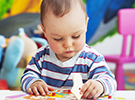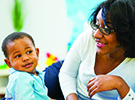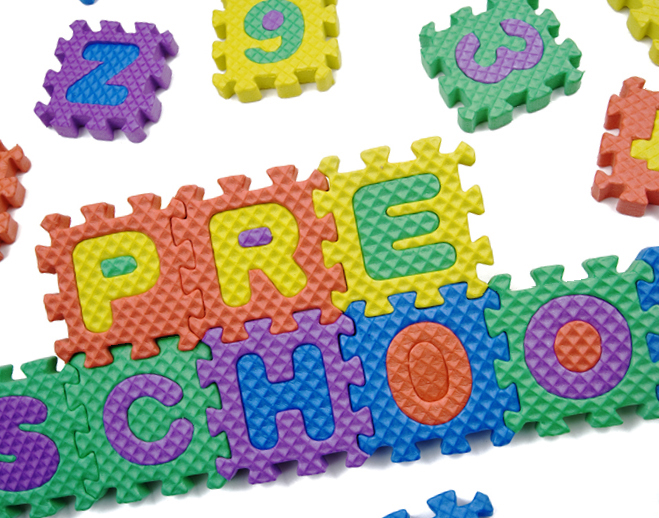Playtime: Empty/Full
Lesson for:
Infants
Content Area:
Algebra
Geometry
Numbers and Operations
Routine:
Indoor Play

Playtime: Empty/Full
Lesson plan for infants 0 to 6 months
Step 1: Review developmental stage: 0 to 6 months.
Play: Infants begin by using their eyes to explore toys and then begin to use their hands and mouths to explore. Their play is primarily shaking, banging and mouthing. At the end of this stage, they begin to look for dropped toys and may find a partially hidden object.
Communication: Young infants recognize their parents and familiar caregivers. They smile and laugh during playful interactions such as peek-a-boo. They make early cooing and babbling sounds.
Motor: When placed on their tummies, infants learn to hold up their heads and reach for toys. They begin to reach and grasp for objects, beginning with the caregivers’ clothes and hair and then moving on to toys and objects. At the end of this stage, many infants may help hold their own bottles and help bring the bottles to their mouths. They may also begin to take pureed food from a spoon.
Step 2: Gather materials.
- Blanket
- Bin or basket
- Two to four infant toys
Note: Small parts pose a choking hazard and are not appropriate for children age five or under. Be sure to choose lesson materials that meet safety requirements.
Step 3: Engage infant in lesson activities.
It’s never too early to begin play routines like clean-up time! Start playtime by placing the infant on his/her tummy on a blanket. Bring out a low basket or an open bin with just a couple of infant toys inside. Show the basket/bin to the infant and say: “The basket is FULL of toys. Hmmm…which ones will we play with today?” Then slowly take each toy out of the bin and place it on the floor in front of the infant. Say: “Now the bin is EMPTY. No more toys in the bin.” Turn the bin upside down to emphasize the concept.
Encourage the infant to look at and reach for and manipulate the toys. When the infant begins to lose interest in playtime, say: “Playtime is all done.” Pick up each toy and place it in the bin/basket, saying: “Bye-bye (toy’s name)” in a singsong manner. Once the toys are picked up, show the infant the bin/basket again and say: “The bin is FULL of toys now. All of the toys are going bye-bye. Playtime is all done.”

Playtime: Empty/Full
Lesson plan for infants 6 to 12 months
Step 1: Review developmental stage: 6 to 12 months.
Play: At the beginning of this stage, play is mostly shaking, banging and mouthing toys. By the end of this stage, infants begin to combine objects that go together in play. They reach for and hold two objects and may begin to reach for a third. Many infants will look for dropped toys and find partially and completely hidden toys. Many infants enjoy taking objects out of containers and putting them back in.
Communication: At this age, infants respond when their names are called. They may turn their heads, make eye contact and sometimes smile and vocalize. They may look for family members and pets when called by name. They may respond to simple requests made with gestures, such as: “Come here.” They may understand “No” or “Stop.” They may lift their arms to be picked up, clap hands and wave bye-bye. They love to shout and squeal and may be babbling with many different sounds. They may be participating in and sometimes initiating peek-a-boo.
Motor: During this stage, many infants begin to sit by themselves and play. They begin to move by rolling, crawling and cruising. They pick up toys by using a raking motion with their whole hand and, by the end of this stage, they are using their fingers and thumbs to pick up small objects. They may feed themselves small bits of food.
Step 2: Gather materials.
- Blanket
- Bin or basket
- Infant toys (such as blocks, books or balls) OR
- Everyday items (such as cups, bowls or socks)
Note: Small parts pose a choking hazard and are not appropriate for children age five or under. Be sure to choose lesson materials that meet safety requirements.
Step 3: Engage infant in lesson activities.
If you haven’t started a clean-up routine with the infants in your care, it’s important to begin at this stage. To start playtime, sit down across from the infant with a low basket or open bin with toys or everyday items inside. Show the basket/bin to the infant and say: “The basket is FULL of toys. Hmmm…which ones will we play with today?” Encourage the infant to take the toys out of the bin. Talk about each toy or item that the child takes out of the bin by commenting on colors, shapes and function. If the infant wants to dump the whole bin, that’s okay too. Once the bin is EMPTY, say: “Now the bin is EMPTY. No more toys in the bin.” Turn the bin upside down to emphasize the concept.
When the infant begins to lose interest in playing with these toys or playtime is over, say: “Playtime is all done.” Encourage the infant to help you pick up each toy and place it in the bin/basket, saying: “Bye-bye (toy’s name)” in a singsong manner. Once the toys are picked up, show the infant the bin/basket again and say: “The bin is FULL of toys now. All of the toys are going bye-bye. Playtime is all done.”

Playtime: Empty/Full
Lesson plan for infants 12 to 18 months
Step 1: Review developmental stage: 12 to 18 months.
Play: At the beginning of this stage, many infants are imitating the use of everyday objects such as cups and spoons. This moves into early pretend play, when the infant may feed you or pretend to drink from a cup or eat off of an empty spoon. They also are great imitators and may enjoy imitating daily activities. They may enjoy putting multiple objects into containers and systematically searching for hidden toys and objects. Many infants will pat pictures in books and sometimes vocalize while looking at books.
Communication: At the beginning of this stage, many infants begin to respond to one-step directions such as: “Give me the ball.” They may need gestures to help them understand the direction. At the end of this stage, many infants follow a related two-step direction without the help of gestures, such as: “Get the ball and give it to Daddy.” They may be pointing to ask for wants and needs and to ask you to name objects. At around 12 months of age, many infants say one to three words on their own and, by the end of this stage, may say up to 15 words or more. Many infants play turn-taking games at this stage.
Motor: At the beginning of this stage, many infants are crawling and cruising to get around and, by the end of this stage, infants are walking with good balance. They may also enjoy walking while carrying large objects and pulling toys. When given a crayon for the first time, they may mouth the crayon or mark the paper. By the end of this stage, many infants are scribbling on paper. They may be starting to scoop food with a spoon and actually get some to their mouths. Infants may also be using a straw or an open cup to drink.
Step 2: Gather materials.
- Bin, basket, bowl or ball popper
- Infant toys (such as blocks, books or balls) OR
- Everyday items (such as cups, bowls or socks) OR
- Pretend play items (such as a refrigerator and food)
Note: Small parts pose a choking hazard and are not appropriate for children age five or under. Be sure to choose lesson materials that meet safety requirements.
Step 3: Engage infant in lesson activities.
Infants at this age are fill and dump masters! They love to EMPTY everything and then put the items back in again. Provide many different sizes and types of containers and many different sizes and types of child-safe objects—from toys to real objects—and just follow the child’s lead. Be sure to comment when the bin is FULL, especially right before the child is about to EMPTY that bin onto the floor. Then emphasize EMPTY by holding up the EMPTY bin and shaking it so that nothing is left to fall out. When the infant begins to lose interest in playing with these toys or playtime is over, say: “Playtime is all done.” Encourage the infant to help you pick up each toy and place it in the bin/basket, saying: “Bye-bye (toy’s name)” in a singsong manner. Once the toys are picked up, show the infant the bin/basket again and say: “The bin is FULL of toys now. All of the toys are going bye-bye. Playtime is all done.” Celebrate your hard work cleaning up together with a high-five or a hug!

Reflections on this lesson
How might you teach the math lesson EMPTY and FULL during other daily activities and routines?
What books do you have in your child care setting that reinforce the math concept of EMPTY and FULL?
What songs or finger plays do you typically use in your child care setting that reinforce the math concept of EMPTY and FULL?
Comment on this lesson